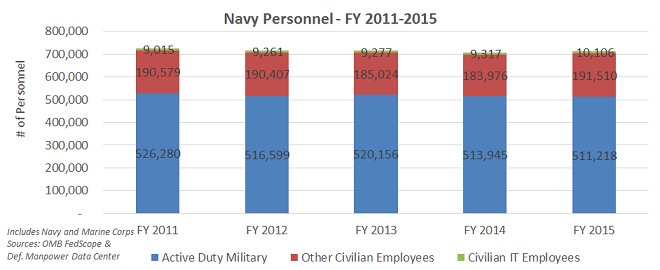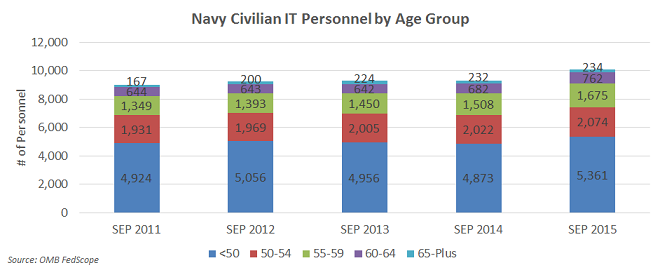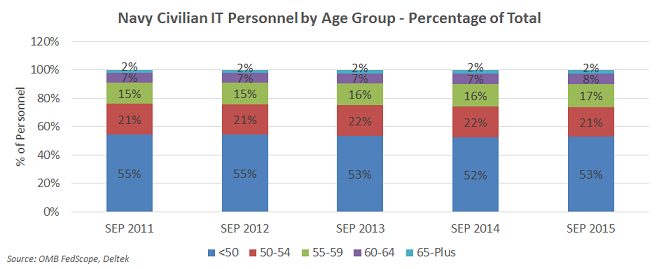Navy Implications of DoD’s New Civilian Employee Phased Retirement Program
Published: June 22, 2016
DEFENSEIT WorkforceNAVYPolicy and Legislation
The Pentagon just made it easier for retirement-aged employees to phase-in their retirement by working part-time, and that has implications for the IT workforce at the Navy.
Department of Defense (DoD) officials recently released a department-wide policy called the Phased Retirement Program, a new option “that allows retirement-eligible full-time civilian employees to request to work part-time while receiving a portion of their retirement annuity,” according to the media release.
“As more employees become eligible for retirement, the program will assist DoD components and agencies with the transfer of knowledge and provide continuity of operations on a short-term basis, officials said, adding that it offers eligible employees the opportunity to transition into retirement while providing mentorship and development for the next generation of emerging subject-matter experts.”
Participation in the program is voluntary and will require DoD approval and compliance with Office of Personnel Management regulations and any component-specific guidance that is implemented.
The official memo from the DoD Undersecretary for Personnel and Readiness defines what a “retirement-eligible employee” is as an employee eligible under the Civil Service Retirement System or the Federal Employees Retirement System who has at least 30 years of service and is at least 55 years old, or who has at least 20 years of service and is at least 60 years old. Employees must have been employed on a full-time basis for at least a consecutive 3-year period immediately before entering into phased retirement status. Employees who qualify for the special retirement program for law enforcement officers, firefighters, nuclear materials couriers, or air traffic controllers are not eligible for the new program.
Under the new program, the phased retiree will work one-half the number of hours he or she worked as a full-time employee immediately before entering phased retirement.
Navy and Marine Corps Personnel Trends
The new policy impacts thousands of civilian employees at the Department of the Navy (DoN), which includes the Marine Corps. Not only does the Navy maintain thousands of active duty military personnel, it employs thousands of civilians to support Naval operations and ashore establishments, including IT.
Shifting strategies and demands have impacted the overall Navy personnel mix over the last five fiscal years (FY). (See chart below.)

Observations
- The number of active military has been declining while civilian personnel is being sustained, with the former down 2.9% since FY 2011 and the latter up 1.0%.
- The reason for active military decline is cuts to the Marine Corps – down nearly 18K and 9%. Navy military personnel is actually up almost 1%.
- Navy’s relative proportion of civilian to military personnel had been declining slightly until a hiring influx in FY 2015, (i.e. the trend had been for fewer civilian employees.)
- Civilian personnel growth from FY 2014 to 2015 was more than 8,300, rebounding from drops in FY 2013 and FY 2014
- Civilian personnel tends to run between 27% and 28% of the total workforce.
- IT employment consistently grew across the time period
Navy and Marine Corps IT Employment
Centering solely on civilian IT employment and the mix of age groups over the last five fiscal years brings things into greater focus. Over the time frame we have seen the overall civilian IT workforce at the Navy grow, but also grow at the upper end of the age scale. (See chart below.)

Observations
From FY 2011 to FY 2015 the following shifts in Navy IT employment in the age groups shown above have occurred:
- <50 grew by 437 people, +9%
- 50-54 grew by 143 people, +7%
- 55-59 grew by 326 people, +24%
- 60-64 grew by 118 people, +18%
- 65-Plus grew by 67 people, +40%
- Total civilian IT employment grew by 1,091 people, +12%
Granted, some of these shifts occurred naturally as people aged, assuming they remained employed by the Navy. However, not all of this growth in the upper age brackets can be explained by time. Some of it is likely due to new hiring of staff in those age groups.
Looking at these employment figures from a slightly different angle helps put them in greater perspective. When we compare the respective age groups from the perspective of their relative proportion of the total employed IT workforce we can see some subtle but clear shifts toward a slightly older workforce mix. (See chart below.)

Implications
While we cannot draw too many broad conclusions based on the limits of this data, the need to retain and/or hire these staff may be to gain the knowledge, skill sets, and experience necessary to maintain the Navy’s legacy systems or aid in their migration to more modernized applications or environments (i.e. cloud.) The DoD’s media release clearly noted that the reason for the policy was to allow retiring employees to provide knowledge-transfer and mentorship to the next generation of Defense employees. The earlier conclusion fits with this stated goal.
Given this new DoD phased retirement policy it is likely that we may see the numbers and relative percentages in the upper age groups of IT staff continue to grow in the coming years, and this can provide needed continuity and experience as the Navy, and its supporting contracting partners, seek to move Navy IT systems forward into the future.